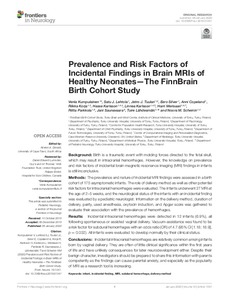Prevalence and Risk Factors of Incidental Findings in Brain MRIs of Healthy Neonates — The FinnBrain Birth Cohort Study
Venla Kumpulainen; Satu J. Lehtola; Jetro J. Tuulari; Eero Silver; Anni Copeland; Riikka Korja; Hasse Karlsson; Linnea Karlsson; Harri Merisaari; Riitta Parkkola; Jani Saunavaara; Tuire Lähdesmäki; Noora M. Scheinin
https://urn.fi/URN:NBN:fi-fe2021042822580
Tiivistelmä
Background: Birth is a traumatic event with molding forces directed to the fetal skull, which may result in intracranial hemorrhages. However, the knowledge on prevalence and risk factors of incidental brain magnetic resonance imaging (MRI) findings in infants is still inconclusive.
Methods: The prevalence and nature of incidental MRI findings were assessed in a birth cohort of 175 asymptomatic infants. The role of delivery method as well as other potential risk factors for intracranial hemorrhages were evaluated. The infants underwent 3T MRI at the age of 2–5 weeks, and the neurological status of the infants with an incidental finding was evaluated by a pediatric neurologist. Information on the delivery method, duration of delivery, parity, used anesthesia, oxytocin induction, and Apgar score was gathered to evaluate their association with the prevalence of hemorrhages.
Results: Incidental intracranial hemorrhages were detected in 12 infants (6.9%), all following spontaneous or assisted vaginal delivery. Vacuum-assistance was found to be a risk factor for subdural hemorrhages with an odds ratio (OR) of 4.7 (95% CI [1.18; 18.9], p = 0.032). All infants were evaluated to develop normally by their clinical status.
Conclusions: Incidental intracranial hemorrhages are relatively common among infants born by vaginal delivery. They are often of little clinical significance within the first years of life and have unlikely consequences for later neurodevelopment either. Despite their benign character, investigators should be prepared to share this information with parents competently as the findings can cause parental anxiety, and especially as the popularity of MRI as a research tool is increasing.
Kokoelmat
- Rinnakkaistallenteet [27094]
